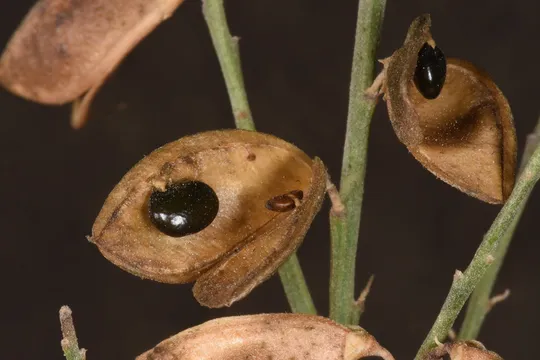Gonocytisus pterocladus





Gonocytisus pterocladus grows at only
ten sites in the Western Upper Galilee, in HaSulam Ridge in the Hanita-Tarshiha
section. The sites are located along the road going up to Hanita (on the edge
of a planted pine grove and on the western slope of dense woodland growing on Cenomanian
chalk); on Mount Manor, on Mount Ukhman (there too on chalk), in the Kziv Stream
near En Tamir, on the Bilton Reserve, west of
Mi’ilya, west of Tarshiha and west of Sha'al Stream. The largest
population is located in the Hanita section.
Chalk and marl in the rainy Mediterranean region
up to an altitude of 800 m. In southern Lebanon, it is dominant on exposed chalk
on steep slopes together with Pinus brutia, but in the Galilee, it accompanies
the P. halepensis plant association.
The genus Gonocytisus belongs to the tribe Geniseae in the Fabaceae family.
This tribe included mostly thorny shrubs whose center of distribution is Mediterranean.
In the flower, the lower parts of the stamen filaments are fused, forming a closed
tube. The tribe includes some of the most common plants in Israel: Calicotome
villosa, Spartium junceum, Genista fasselata and Retama
raetam. In the genus Gonocytisus two species grow in the
Eastern Mediterranean Basin, from western Turkey to Israel. The species G.
angulatus is endemic to Turkey and grows there in the Mediterranean region. G. pterocladus
replaces it from the Amanus Mountains through western Syria and Lebanon to the
Upper Galilee. The genus Gonocytisus is very close to Cytisus
that includes about 50 species and is very common in the Mediterranean
countries, but not in Israel. Gonocytisus differs from it by its anthers
that have ciliate hairs at their base and at their head, unlike the glabrous
anthers in the entire species group close to Cytisus.
·
In Israel, Gonocytisus pterocladus is unique to the western Upper Galilee on chalk and marl substrates.
The number of its sites is small, but seems relatively stable now.
·
The plants are scattered throughout the sites, but in
small patches. The sites are close to each other in one section about seven
kilometers long. Most of the populations are small and the largest population
is in the Hanita area numbers only 300 items.
·
The plant’s fertility is high and it also produces seeds
by self-pollination. After the fruit opens in late summer and autumn, the seeds
fall near the mother plant. G. pterocladus seeds from the Hanita population were successfully
germinated in the nursery (M. Ron, pers. comm). In nature, nothing is known
regarding the species' renewal by germination.
·
Most of the G.
pterocladus populations grow on
inaccessible sites and therefore will probably not be affected by development. The
Hanita population, although it is very close to the kibbutz and is located at
the roads edge and in a built-up area, is currently difficult to access.
However, a part of the Hanita population is located in areas with a high development
potential. The shade of the planted pine forest in Hanita may lead to the deterioration
of the shrubs.
·
G. pterocladus is protected by law. A small part of the Hanita plants
are located in a nature reserve, but most are not. The sites on Mount Ukhman
and Mount Manor are located in a nature reserve.
Gonocytisus pterocladus should be monitored at all the sites in which it grows,
to ensure that the number of its plants is not declining. The trees in the Hanita
pine forest should be regularly thinned to allow the G. pterocladus shrubs to develop. In view of its ease of propagation and rapid
development, plants should be cultivated in refuge gardens and used as summer
ornamentals for landscaping in communities located near the natural sites. The
possibility of reinforcing natural populations by planting should be considered.
Gonocytisus pterocladus has an eastern Mediterranean distribution – from the
Amanus Mountains in southeastern Turkey, through the Mediterranean regions of
Syria and Lebanon west of the watershed and up to the northern Upper Western Galilee.
Gonocytisus pterocladus is a tall shrub that grows exclusively on
chalk and marl in the western Upper Galilee, in one section, on a limited
number of sites. It is threatened by its rarity, its small populations, its sensitivity
to shade and the possibility of future development on some of is sites. G.
pterocladus is classified as a red species due to its
attractiveness and as the Western Galilee is at the extreme southern edge of
its range.
גליל, י. 1980. "צלען הגליל - צמח הזקוק להגנה". בתוך: ידעיה, מ. (עורך), במערבו של הגליל - קובץ בוטאני. הוצאת החוג האזורי ליד"הא - גליל מערבי.
כהן ע. ושמידע, א. 1992 - צלען הגליל. "טבע וארץ", 249 (5): 40-42.
כהן,א. וא.שמידע, 1992, ספר המידע האדום - צמחים נדירים בישראל, כרך א' - הצמחים הנדירים של הגליל העליון. רשות שמורות הטבע, החברה להגנת הטבע.
Current Occupancy Map
| 1000 squre meter pixel | 5000 squre meter pixel | 10000 squre meter pixel | |
|---|---|---|---|
| number of observations | 0 | 0 | 0 |
| in total pixels | 0 | 0 | 0 |
| Family | Fabaceae |
| Classification | On the endangered species list |
| Ecosystem | Mediterranean |
| Chorotype | Eastern Mediterranean |
| Conservation Site | Tsal'an plot near Hanita |
| Rarity |
1
3
6
|
|---|---|
| Vulnerability |
0
1
4
|
| Attractiveness |
0
1
4
|
| Endemism |
0
1
4
|
| Red number |
1
3.7
10
|
| Peripherality | N |
| IUCN category | DD EW EX LC CR EN VU NT |
| Threat Definition according to the red book | Vulnerable |
 Based on:
Based on:






